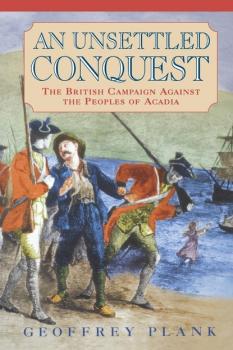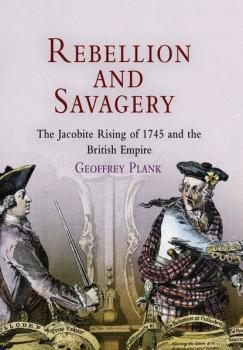ТОП просматриваемых книг сайта:
Geoffrey Plank
Список книг автора Geoffrey PlankАннотация
The former French colony of Acadia—permanently renamed Nova Scotia by the British when they began an ambitious occupation of the territory in 1710—witnessed one of the bitterest struggles in the British empire. Whereas in its other North American colonies Britain assumed it could garner the sympathies of fellow Europeans against the native peoples, in Nova Scotia nothing was further from the truth. The Mi'kmaq, the native local population, and the Acadians, descendants of the original French settlers, had coexisted for more than a hundred years prior to the British conquest, and their friendships, family ties, common Catholic religion, and commercial relationships proved resistant to British-enforced change. Unable to seize satisfactory political control over the region, despite numerous efforts at separating the Acadians and Mi'kmaq, the authorities took drastic steps in the 1750s, forcibly deporting the Acadians to other British colonies and systematically decimating the remaining native population. The story of the removal of the Acadians, some of whose descendants are the Cajuns of Louisiana, and the subsequent oppression of the Mi'kmaq has never been completely told. In this first comprehensive history of the events leading up to the ultimate break-up of Nova Scotian society, Geoffrey Plank skillfully unravels the complex relationships of all of the groups involved, establishing the strong bonds between the Mi'kmaq and Acadians as well as the frustration of the British administrators that led to the Acadian removal, culminating in one of the most infamous events in North American history.
Аннотация
In the summer of 1745, Charles Edward Stuart, the grandson of England's King James II, landed on the western coast of Scotland intending to overthrow George II and restore the Stuart family to the throne. He gathered thousands of supporters, and the insurrection he led—the Jacobite Rising of 1745—was a crisis not only for Britain but for the entire British Empire. Rebellion and Savagery examines the 1745 rising and its aftermath on an imperial scale. Charles Edward gained support from the clans of the Scottish Highlands, communities that had long been derided as primitive. In 1745 the Jacobite Highlanders were denigrated both as rebels and as savages, and this double stigma helped provoke and legitimate the violence of the government's anti-Jacobite campaigns. Though the colonies stayed relatively peaceful in 1745, the rising inspired fear of a global conspiracy among Jacobites and other suspect groups, including North America's purported savages. The defeat of the rising transformed the leader of the army, the Duke of Cumberland, into a popular hero on both sides of the Atlantic. With unprecedented support for the maintenance of peacetime forces, Cumberland deployed new garrisons in the Scottish Highlands and also in the Mediterranean and North America. In all these places his troops were engaged in similar missions: demanding loyalty from all local inhabitants and advancing the cause of British civilization. The recent crisis gave a sense of urgency to their efforts. Confident that «a free people cannot oppress,» the leaders of the army became Britain's most powerful and uncompromising imperialists. Geoffrey Plank argues that the events of 1745 marked a turning point in the fortunes of the British Empire by creating a new political interest in favor of aggressive imperialism, and also by sparking discussion of how the British should promote market-based economic relations in order to integrate indigenous peoples within their empire. The spread of these new political ideas was facilitated by a large-scale migration of people involved in the rising from Britain to the colonies, beginning with hundreds of prisoners seized on the field of battle and continuing in subsequent years to include thousands of men, women and children. Some of the migrants were former Jacobites and others had stood against the insurrection. The event affected all the British domains.
Аннотация
The abolitionist John Woolman (1720-72) has been described as a «Quaker saint,» an isolated mystic, singular even among a singular people. But as historian Geoffrey Plank recounts, this tailor, hog producer, shopkeeper, schoolteacher, and prominent Quaker minister was very much enmeshed in his local community in colonial New Jersey and was alert as well to events throughout the British Empire. Responding to the situation as he saw it, Woolman developed a comprehensive critique of his fellow Quakers and of the imperial economy, became one of the most emphatic opponents of slaveholding, and helped develop a new form of protest by striving never to spend money in ways that might encourage slavery or other forms of iniquity. Drawing on the diaries of contemporaries, personal correspondence, the minutes of Quaker meetings, business and probate records, pamphlets, and other sources, John Woolman's Path to the Peaceable Kingdom shows that Woolman and his neighbors were far more engaged with the problems of inequality, trade, and warfare than anyone would know just from reading the Quaker's own writings. Although he is famous as an abolitionist, the end of slavery was only part of Woolman's project. Refusing to believe that the pursuit of self-interest could safely guide economic life, Woolman aimed for a miraculous global transformation: a universal disavowal of greed.
Информация о книге
Автор произведения Geoffrey Plank
Жанр Биографии и Мемуары
Серия Early American Studies



